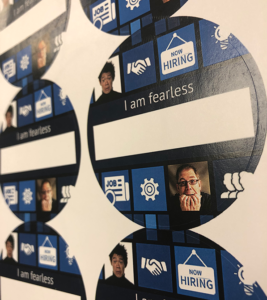This post is a recap of the March 2, 2020 Hudson Job Search presentation.
How to become a Super Interviewer
You’ve refreshed your resume, wrote a carefully crafted cover letter, flew through the phone screen, and thought you nailed the face to face interview. And, you didn’t land the job. Again. “What in the world am I doing wrong?” you ask yourself.
Getting interviews is easy. Interviewing is the real fight.
What if you could have a world-class Human Resources pro share their top-secret interviewing tips? Would you be interested in transforming from an average interviewer into “THE” ideal candidate? Would you like to become a real Super Interviewer?

Presenter Michael Polovick is Vice President of Hudson Job Search and was most recently VP of Human Resources for The Smithers Group.
He has more than 30 years of HR leadership experience with both privately held organizations and publicly traded Fortune 500 companies including Bridgestone, Pirelli, Continental Tire, and The Linde Group, where he led the hiring process for thousands of employees including start-up’s as well as existing businesses.
Michael retired Vice President of Human Resources for The Smithers Group, a multinational scientific testing and consulting company, will conduct the program. He currently serves as a Board Member of the University of Akron Human Resources Advisory Committee, Vice President of Hudson Job Search, and Facilitator of the Department of Job and Family Services, Summit County Ohio Means Jobs Executive Networking Group. Since retiring he has focused much of his time on paying forward, especially to job seekers looking to enhance their employment prospects.
Why interview, anyway?
There are two main factors companies consider when interviewing any candidate:
- Technical fit (do you have the skills to do the job?); and
- Cultural fit (are you the “right” person for this particular place?)
Moving from people to pixels
You know the drill: Fill out a job application. Submit your resume and cover letter. Make it through the phone screen and get invited to a face to face interview. Right? Well… maybe. Just like technology has birthed the beastly ATS (applicant tracking system software,) in-person interviews may soon be replaced by pixels. (More on that in a second…)
Interview types’ features and benefits
These interview types are still the primary players in the recruitment process:
1:1
Feature: The textbook face-to-face meeting with a recruitment team member or hiring manager.
Pro/Con: Long-held traditional/conservative interview scenario, focused, quality time and attention by hiring party, and private conversation.
Serial Interview
Feature: A scheduled, repetitive sequence of separate 1:1 interviews with various company representatives that typically will last for several hours in total.
Pro/Con: Job candidate meets a variety of employees and has an opportunity to get a holistic view of the organization; however 80% of the questions asked by interviewers are likely to be the same as the ones before.
Panel Interview
Feature: A group meeting with a number of people in the same room, at the same time.
Pro/Con: It can be intimidating yet it’s the most efficient and streamlined meeting design for each party and is to the advantage of the job candidate. Interviewers can hear questions others ask and benefit from the job candidate’s answers. The candidate does not have the exhaustive repeat answers to contend with and will likely remain sharper and more focused. The panel can then evaluate the candidate post-interview and share perceptions immediately, speeding up the hiring process.
Asynchronous Interview
Feature: Recorded video interviews where the interviewer and interviewee are not participating simultaneously.
Pro/Con: Candidate can practice their answers and record once the “warmup” is complete. The interviewer can review the taped answers at their leisure. Often available to record/review 24/7/365 offering time flexibility, efficiency and consistency as each candidate are asked the identical questions, eliminating human error in a live interview setting. Spark Hire is one example of this burgeoning technology.
Top Tech Tips
- Check out your computer system: make sure everything is working.
- Prepare your surroundings: what will the interviewer see in the background? Is it appealing? Distracting?
- Focus on lighting: are you in the shadows or a spotlight? Aim for even lighting.
- Dress to impress: wear your best interview attire.
- Control your environment: silence phones, sequester barking dogs, meowing cats or screaming kids.
- Treat like any other interview: imagine your interviewer is with you on the other side of the camera.
Blunder Buster to the rescue!
The Top 10 Interview Blunders and How to Avoid Them:
Blunder #1: Failing to do your research/homework.
- Know your own story. Be the candidate that knows their resume and their story inside and out.
- Google. Google. And more Google. There is no excuse for not being informed about the company for which you are interviewing. Read their website, research news stories, check out their social media posts.
- Know thy interviewer. LinkedIn is a fantastic resource to discover more about the people you are meeting with. Find a common bond and be ready to share something you learned about them.
- Learn and practice your answers to the most likely asked questions. Need some examples? Google “Most common job interview questions.”
- Have good questions prepared in advance. Stuck on what questions to ask? Google “What are good questions to ask employers?”
Blunder #2: Failing to connect with your interviewer(s).
- Dress appropriately.
- Practice your power handshake.
- Smile.
- Engage in some small talk. Use that LinkedIn common bond you learned above to build rapport.
- Make eye contact. There is nothing worse than a candidate staring at their notes the entire interview.
Blunder #3: Talking too much.
- Don’t try to eat the interview apple in one bite. Strive for a 60-second answer (or less) to each question.
- Pace yourself. It is not a race. It’s a conversation.
- Listen and be present instead of thinking ahead of the interviewer and planning your next answer.
- Use the P-A-R story when answering questions: Present a Problem you faced; Demonstrate the Actions you took to solve it; Describe the Results you achieved.
Blunder #4: Not answering the question.
- Avoid verbally dancing around the answer.
- Listen.
- Do your homework.
- Practice your answers out loud. Record yourself and play it back. Do you like what you hear?
Blunder #5: Talking about the job description instead of your accomplishments.
- Prove your value.
- Show the ROI you bring. Quantify your results. Use numbers, percentages, dollar amounts. How much did you save, gain, expand, etc.?
- Use “I” vs. “we.” A job interview is the one time where talking about yourself is OK. In fact, it is essential. The company is not hiring your whole team, they are interested in you. So, you can preface your comments with a statement like “While being a team player is core to my work style, I know you are not hiring my team, so here is what my role was on the project…”
Blunder #6: Thinking that it is all about me.
- It’s not all about you. It’s really all about them.
- Employers are selfish.
- Companies want you to add value. What can you offer them?
Blunder #7: Talking about what you would do versus what you did.
- The past is the best predictor of the future.
- Provide specific examples of your achievements.
- Link past achievements to the specific employer’s needs.
Blunder #8: No sign of interest.
- Your body language and energy speak volumes about you. Are you sending the right message?
- Ask good questions.
- Ask about next steps in the recruitment process.
- Close with a strong statement of desire for the job. Show gratitude for the interviewer’s time and leave no doubt in their mind that you want the job and what value you can bring.
Blunder #9: Failing to follow up.
- The sooner the better. Email is fine and immediate. You can always send a note in the mail as well.
- Make it personal. Include a takeaway from the interview in your note. Is there a point you found interesting in your discussion? Do you want to expand on an answer you gave? This is especially important in a panel interviewer. A “group” thank you will never do. Plan to write to each individual on that panel and customize your note. Don’t embarrass yourself with a generic thank you – they may compare notes. This is not the time to take the easy route.
- Keep your commitments. If you said you will provide more information to them today, do.
- Ask when and how you can best follow-up (which method of contact does the interviewer prefer?)
Blunder #10: Badmouth a former employer.
- It’s OK to show disappointment, but not displeasure. If you were laid off, you may say something like: “While I was disappointed the company eliminated my department, I fully understand this was the best business decision for them at the time.”
- Don’t lie, gossip or share confidential information about the company or its employees.
Bonus Time!
According to a Jobvite survey of more than 2000 recruiters here are some interview deal-breakers.
Behavioral Deal Breakers:
86% | Being rude to the receptionist/staff. Keep in mind your interview starts the minute you have that initial engagement with the company. From a phone call to an email, or an in-person greeting. Treat everyone with equal dignity and respect. You have no idea about the relationships they may have with your desired new boss.
71% | Checking your phone. Leave it in the car. Period.
58% | Showing up late. Set an alarm. Plan double the travel time needed to arrive on time. Enough said.
52% | Bad hygiene. Shower, brush your teeth, style your hair, press your clothes. Think of an interview as a first date. You want a second date, right? Show up in style.
39% | Interrupting the interviewer. Listen twice, talk once. Let the interviewer lead the dance.
Social Media Deal Breakers:
61% | Marijuana in posts. Unfriend yourself from Maryjane.
51% | Political rants/positions. Leave those for the in-person discussions with friends.
48% | Spelling/grammar errors. If you don’t have attention to detail at this base level, how can I trust you will be diligent and detailed with more critical matters?
35% | Alcohol consumption. You aren’t at a frat party. Leave the beer bong pictures offline.
Your interview toolbox checklist:
- Have enough copies of your resume on hand to give to each person interviewing you.
- Prepare a thoughtful and intelligent list of questions to ask.
- Bring a copy of the cover letter you sent to the company to refer to if necessary. Don’t assume you will remember the subtle nuances you mentioned in this particular application. There is nothing worse than mentioning something new you think you shared and didn’t.
- Consider having a few recommendation letters with you to point out how others view your contributions.
- Create a “top 3” list: three things you want to be sure to get across and find a way to weave those points into your answers.
- Think about the question(s) you hope they don’t ask you. Have solid and confident responses to those ready.
- Ask the interviewer what method of contact they prefer for follow-up and suggest a timeframe when you will reconnect with them.
The Last Words
If you are out of work, in transition, or underemployed today, you are not alone. You are important because of WHO you are not only WHAT you do. Make sure your worst enemy doesn’t live between your ears.
Just follow the tips above on the 10 biggest blunders to avoid during an interview, and you will have a fearless and successful experience!
And, if you feel you didn’t do your absolute best or missed a question, don’t fret. Redeem yourself in your follow up letter to the interviewer. (Remember blunder #9?) Use your follow up communication to clarify a missed point or a mistake you made. Then, remember to restate why your experience is a good match for the position. And finally, remind the interviewer that you are very interested in the job! Success to you!
Save the Date for the Next Hudson Job Search Meeting!
Hudson Job Search meets the first and third Monday evenings at Christ Church Episcopal, 21 Aurora St. with sign-in and networking at 7:00 – 7:30 p.m. The meeting is from 7:30 – 9:00 p.m. All our events are free of charge and open to anyone who lives and works in the greater NEO area, whether you currently have a job or not. No need to register in advance, but seating is limited to approximately 40 individuals. Please dress business casual. Park behind the church and come to the Parish Hall. Visit our Events link for upcoming meeting topics.



